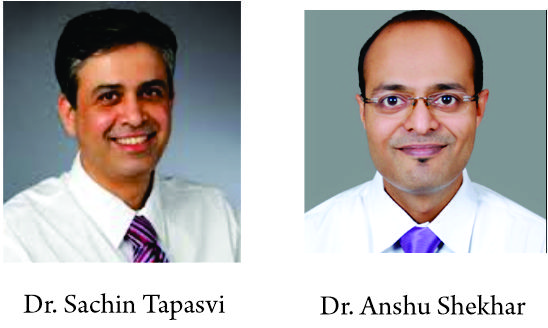OrthoBiologics: The New Frontier in Knee Osteoarthrosis
Sachin Tapasvi, Anshu Shekhar
Volume 4 | Issue 3 | Sep – Dec 2019 | Page 1-2
Author: Sachin Tapasvi [1], Anshu Shekhar [1]
[1] Orthopaedic Speciality Clinic, Pune Mahatrahtra.
Address of Correspondence
Dr Sachin Tapasvi
AJA Editorial Office, A-203, Manthan Apts, Shreesh CHS, Hajuri Road, Thane [w], Maharashtra, India.
Email: asian.arthroscopy@gmail.com
OrthoBiologics: The New Frontier in Knee Osteoarthrosis
The body has an enormous potential to heal by itself. This potential needs to be explored and exploited, rather than bridled in jargon and mundane complexities of traditional science. It is perhaps this realization that has led to remarkable strides in the magic of “orthobiologics” in the last decade. Orthobiologics are biologically derived materials that intend to induce healing and regeneration of tissues[1]. These have in fact, emerged as a sub-speciality of therapeutic interventional modalities to cure or control an entire gamut of orthopaedic problems, ranging from traumatic to degenerative in etiology. This special edition of the Asian Journal of Arthroscopy visits the biological options available to manage osteoarthrosis of the knee and the currently employed non-surgical tools in nine review articles.
In their review of orthobiologics for treatment for knee osteoarthrosis, Crane et al noted that the bewildering array of treatments and combinations available could actually be a deterrent to patients and providers. Thought the safety of all these methods is not doubted at present, they stressed the need to develop algorithms for the appropriate use of orthobiologics[2]. Even for applications in sports medicine, this therapeutic modalities has shown promising results and the future developments looks exciting[3]. Although intra-articular hyaluronic acid (IAHA) supplementation can be considered an orthobiologic, skeptics would disagree as it does not wield any disease modifying effects in knee OA. Nonetheless, due to proven safety and efficacy record, it is imperative that any newer therapy would first be compared with IAHA[4]. The first orthobiologic to be used in clinical applications is platelet rich plasma (PRP) and it has evolved into its several forms today. Both leucocyte-rich and leucocyte-poor PRP has been safe and effective in early knee OA and has been shown to be superior to intra-articular hyaluronic acid injections in a meta-analysis [4]. Combination therapy of intra-articular PRP with hyaluronic acid and intra-osseous injections of PRP are the emerging trends but need further investigation[5][6].
Besides PRP, the “newer” methods like autologous conditioned serum, bone marrow aspirate concentrate and adipose derived stromal cell therapy have seen significant real world application and are discussed in detail in this issue. Bone marrow aspirate concentrate (BMAC) has been around for a while and has generally been found to be a safe procedure which relieves pain in selected cases[7]. However, the mechanism of pain relief remains to be proven and even its superiority over placebo normal saline injections could not be demonstrated in a randomized controlled trial at 12 months[8]. The largest study to date assessing adipose derived stromal vascular therapy in knee OA showed improvements in patient reported outcomes as well as chondral thickening on MRI scans [9]. The new development in this arena is the use of microfragmented adipose tissue, where the stem cells are not subjected to manipulation or expansion. This has shown encouraging early results and can potentially be used for all stages of knee OA [10]. Interleukin 1 receptor antagonists like autologous conditioned serum and autologous protein solution have also shown positive results in preliminary studies but the experience is limited. The use of Alpha 2 macroglobulin; Stem cell based approaches like embryonic stem cells and induced pluripotent stem cells and Gene therapy have been investigated in animal models and are likely to provide disease-modifying options in the future [11-13].
The frontier is wide open and the possibilities are immense. The most important lacuna to be covered is providing good quality data. This will make universal opinions become more aligned and strengthen the science behind orthobiologics, making it more widely acceptable and applicable. These therapies are easily available, inexpensive and present a tangible non-arthroplasty option although long-term effectiveness needs to be proven [14]. The ultimate benefactor shall be the patient as we all still search for the holy grail of managing osteoarthrosis of the knee.
| How to Cite this article: Tapasvi S, Shekhar A. OrthoBiologics: The New Frontier in Knee Osteoarthrosis. Asian Journal of Arthroscopy Sep- Dec 2019;4(3):1-2. |
(Abstract) (Full Text HTML) (Download PDF)




Leave a Reply
Want to join the discussion?Feel free to contribute!